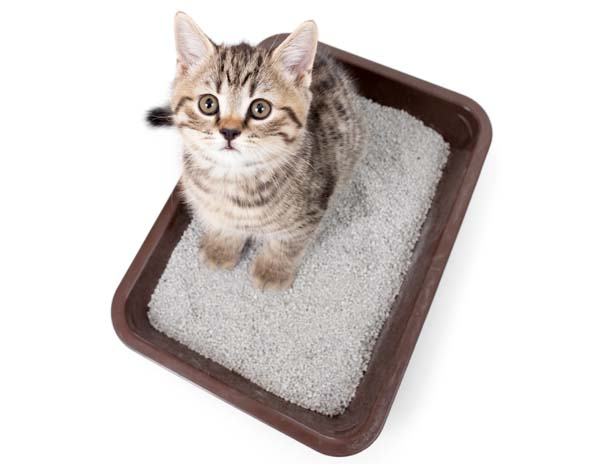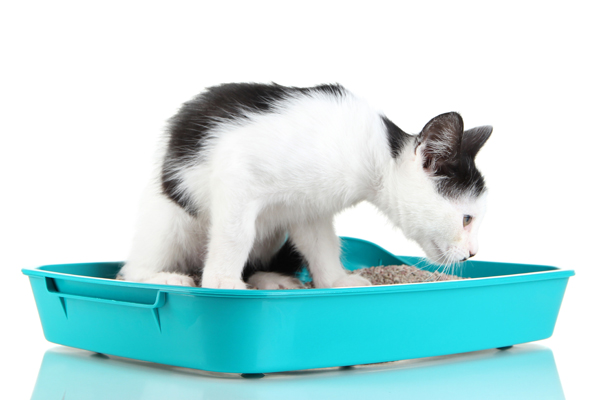Litterbox Size Matters For House Cats
A study conducted at the University of Prince Edward Island’s Atlantic Veterinary College indicated that most cats show a definite preference for a larger litterbox than is typically available to them in their homes and that other factors such as litterbox cleanliness and location may have a compounding influence on this choice.
This study is important because inappropriate elimination, or going outside the box, is the most common cat behavior problem reported by people living with house cats. Failure to use a litterbox is the number one reason for relinquishment of cats to a shelter, abandonment and euthanasia. Yet, little is known about the space preference of cats when they eliminate.
Previous studies have shown that cats tend to have a preference for clumping or fine-grain litter over other commercially available types of litter but litterbox size has been based on what is traditionally available or human convenience factors.
Litterbox Sizes Used in the Study
Schematic diagram to demonstrate litterbox dimensions for the regular (gray 56 x 38 cm) and large (black 86 x 39 cm) boxes used in the study. The median values of the dimensions from the owner’s original boxes were also included. (black 47 x 36 cm) for comparison.
The study chose two different-sized test boxes from the same manufacturer. One box approximated a “regular” litterbox but was slightly larger than what is commercially available as a typical litterbox (referred to as original in the image above). Even though the regular-sized box offered in the trial was larger than the average of the box sizes that were previously available in the test households, most of the cats still preferred to use the biggest box available which was 1.9 times larger in surface area. Both test boxes were rectangular, with approximately the same width and height, only the length was substantially different. Only increasing box size in 1 horizontal dimension was sufficient to show a preference.
Methods and Materials
A total of 73 cats were enrolled in the study. One household with one cat withdrew from the trial by day 7 because the owner believed she was having an allergic reaction to the litter. All other cats remained in the study for the full 28 days. There were 43 households; 19 single cat households, 20 two-cat households, 3 households with 3 cats, and 1 household with 4 cats. All cats were neutered, 36 were male and 36 were female. The mean age of the cats at the time of the study was 3.8 years.
The two litterboxes chosen for the study were located in the same room but as far apart as possible. The cat owners were instructed to use a coin toss to determine the initial relative location of the litterboxes. Cat food could not be located within 3 meters of the boxes and preferably not in the same room. A diagram was used to record the initial location of the boxes and the location of any previous box or boxes that might have been kept in the same room.
Each box was filled with identical unscented clumping litter to a depth of 10 centimeters. Cat owners were provided with a ruler to measure litter depth and were instructed to maintain this depth by topping off the boxes during the course of the study. Litter and two scoops were provided to each household.
Cat owners were provided with a logbook to record the number and types, feces or urine, clumps per day in the two boxes. The logbook included space to record and other events that could have influenced elimination behavior, such as visiting people, pets or illness of the cat. The frequency of elimination in each box over a 4-week period was measured by scooping the boxes at least once daily. On day 15, the boxes were emptied completely, their positions in the room were reversed, they were refilled with clumping litter to a depth of 10 cm, and counting was resumed. As an incentive for completing the trial and returning the logbooks, a draw was held for a number of prizes at the end of the study. 
Results Show Cats Prefer a Larger Litterbox
None of the cats found the new larger litterboxes aversive and some of the cats showed a marked interest in the new larger boxes, engaging in rolling and play behaviors. This type of activity may show that when the larger boxes were new and clean they had qualities that were inherently attractive to the cats. This was the first time the authors of the study encountered reports of cats exhibiting rolling behavior in a litterbox, although cats often exhibit rolling behavior in greeting, in play with other cats.
One expectation was that a larger litterbox may, over time, provide more access to a clean area of substrate for elimination, especially if the box was not being kept meticulously clean by the cat owner. However, this study showed that most cats preferred the larger box, even when both boxes were equally clean, emphasizing the importance of litterbox size in the elimination behavior of cats.
The term inappropriate to describe the failure of a cat to use a litterbox is something of a misnomer according to the authors of this study, as the choice of an elimination area may not be inappropriate from the cat’s perspective. A cat’s failure to use the litterbox is undesirable from the cat owner’s perspective, but from the cat’s perspective such failures include information about that cat’s preferences and needs. Not all cats will require a larger litterbox to behave in a manner that is acceptable to most owners, but it is clear from this study that footprint size of the box is an important factor to many cats and should be included in general management instructions.
Takeaway From This Study
Providing a larger box is a harmless and relatively inexpensive approach to treating elimination behavior of cats. We talk more about your cat and the litterbox in our article Rethinking the Litterbox. Put Yourself in Your Cat’s Paws.
Guy, N. C., Hopson, M., Vanderstichel, R. Litterbox size preference in domestic cats (Felis catus) Journal of Veterinary Behavior 9 2014 78-82.


Joanne, so where can we find these extra-large litter boxes? I have one extra-large size that is an under-the-bed storage container, but it has a “trough” along the outer edge that the pee tends to pool in, so scooping is difficult. Is there any place that sells really large litter boxes, made with scooping in mind?
Lisa, I found a large rectangular shaped Sterilite container at Walmart.
It is about 35″L x 17″ W x 6″H. We are trying this now to see if Annie, Eddie and Mercy prefer this larger size to the other boxes available to them. I have not found products sold as litterboxes in this size.
The litter box-making companies are really missing out here. Perhaps you, with your mass following, could make a convincing argument to some of the box companies.
It is surprising that they aren’t available as litterboxes isn’t it? Although it seems most cat products are the same as they have been for many years. Time for a change.
Oh, and I’ll be checking Walmart for that box!
Lisa, let me know what you think of the box.
A) I am SO glad there are a lot of UNscented options. So many of them bother me, and I cannot imagine how off-putting that is for the feline senses!
B) I too have found that the bigger boxes with higher sides (and a lower edge for entry) work better for my two girls, especially as they got older.
One of them would often misjudge where her back end was…leaving a kitty lake on the rim of the box and onto the floor of the bathroom. So once I realized what was happening I limited the box in use to the higher walled box. NO more surprise icky puddles under the litterbox!
She has been gone for nearly 2 months now…and I even miss that, just a little.
I know how much you miss her, even the mishaps. It is so hard to lose our little family members.
Scents bother me too so I can only try to imagine how scented litter must smell to our cats.
Interesting study. I have larger ones. My kitties do prefer them. Even my kitten wanted the big boxes the boys had.
Sue B
Sometimes it is such a small change that makes a big difference.
Six cats, three littermaids, two regular boxes. These have to do as I’m too arthritic to bend over a box several times a day.
It is a lot of scooping to keep the boxes clean. Have you seen the long handled litter scoop? It has a telescoping handle to make scooping easy without needing to bend over. I have not seen the scoop other an online but it looks like it might be a good tool. Here is the link; http://www.make-life-easier.com/product/laundry+%26+cleaning/cleaning+supplies+%26+tools/longhandledtelescopinglitterscoop.do
Thanks! I’ve just ordered one. Even the litter maid boxes have to be scooped now and then.
I hope this works for you. Let me know because this could be a great scoop for many cat parents.
It may be harmless, but may also be impossible. We have only one place to put a litter box, and it barely fits. We live in a very small apartment. Any larger, and it would not fit. We scoop at least twice a day, and in three years have had no elimination anywhere else.
That is great you are not experiencing any litterbox problems. Every cat is unique and some cats never have a problem using the litterbox.